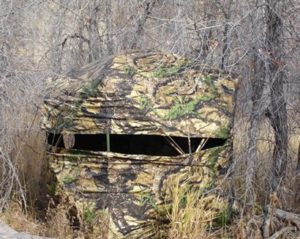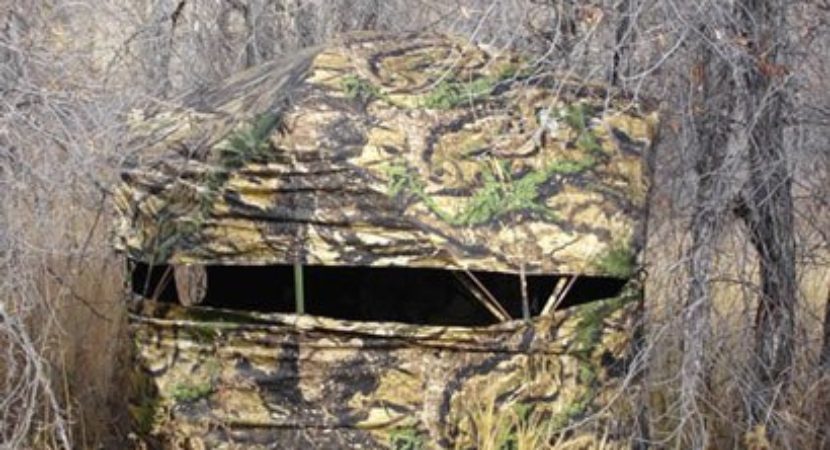 There are several kinds of hunting blinds to choose from, and out of those, there are lots of options you can get with any kind of blind. Fabric blinds give you many choices when it comes to hunting camo patterns and textures. Permanent blinds can be constructed of wood/plyboard, vinyl, polyethylene, fiberglass, aluminum/metal, and other materials. The options really are nearly endless.
There are several kinds of hunting blinds to choose from, and out of those, there are lots of options you can get with any kind of blind. Fabric blinds give you many choices when it comes to hunting camo patterns and textures. Permanent blinds can be constructed of wood/plyboard, vinyl, polyethylene, fiberglass, aluminum/metal, and other materials. The options really are nearly endless.
Questions to ask and answer before deciding which kind of hunting blind you want to purchase
1. Where do you want to place the blind? Is it going to be possible to get a certain kind of blind into the area and set up?
2. Will you be leaving the blind in place or moving it around? Do you need or want a portable solution or something more permanent?
3. What kinds of windows or openings do you need? Will you be hunting from the blind primarily with a gun, a bow, or both?
4. How much are you willing to invest in a hunting blind?
5. What kind of weather will the blind need to survive?
6. How well insulated do you want the blind to be?
7. Do you need storage inside the blind?
8. How many people will be hunting from inside the blind at any one time?
9. Does the blind need to be secure?
10. Will the blind need to be elevated or placed on a tower base of some kind?
The answers to these questions can give you a good idea of where you need to start looking for a good deer hunting blind. In the end, choosing the best hunting blind is going to depend a lot on those answers.
Your needs are going to be different from the needs of other hunters because we’re all individuals with our own hunting styles and preferences. Some of us live in mild winter areas, some of us don’t. You have to decide for yourself which kind of hunting blind is best for you and which options you really want or need your blind to have.
Contents
Hunting Blinds Make It Easier to Take Young Kids Deer Hunting
Deer hunting blinds are one of the most useful hunting accessories you’ll ever own. They can be used for hunting from the ground, from a ladder stand, for handicapped hunters, and for young hunters.
Especially in the case of young hunters, deer hunting blinds stand out as a highly useful tool.
Young children aren’t that good at staying still or quiet. A good hunting blind helps overcome both those obstacles when you’re hunting with younger hunters. A blind offers an enclosed space that will keep down noise and hide extraneous movements. Many blinds are made to provide noise and scent protection.
A deer hunting blind gives you the best possible chance of keeping those young hunters out in the woods and in fields longer without attracting attention from the wild game they’re trying to hunt.
Successful hunting is key to keeping a youth’s interest in hunting high. Over time, they’ll develop an appreciation for the need to stay quiet but while they’re young, if you want to instill a lifelong passion for hunting into your child, they need to experience the rewards of a good hunt. Using a hunting blind helps make that happen, so that when you have venison at your dinner table, your young hunter knows he put it there. (Or she, because instilling a desire in your daughter to hunt wild game can reap just as many rewards as teaching your son to hunt.)
Next time you’re getting ready to take your young hunter out into the field, take a hunting blind with you.
Primos Gunhunter’s Blind
The Primos Double Bull Gunhunter’s Blind was built with the gun hunter in mind. The Gunhunter’s Blind is good for setting up in large open fields or the woods.
This hunting blind is lightweight at about 16 pounds and will fold up for easy carrying. It also has just enough room for a parent and child (sitting on stools) or enough room for one adult hunter. The Gunhunter’s Blind comes in the Ground Swat camouflage pattern.
This ground blind features an adjustable roof that allows you to hunt with it as open as you like or cinched down to a narrow slit that’s just wide enough to get your gun through. The less gap you have in your window system the more likely deer will be relaxed and not take notice of the blind.
This blind also features an adjustable framework and a rotating/locking hub in the blind frame. Adjust the tightness of the fabric by rotating the hub to lengthen the strut. That’s how you eliminate wind flap.
Pros and Cons of Deer Hunting Blinds
Although you can find a variety of reasons why to buy and use deer hunting blinds, there are both pros and cons of hunting from blinds. Here we discuss a variety of the issues you’ll come across when you choose to hunt deer from a blind.
Pros of Deer Hunting Blinds
Concealment is a major factor in the usefulness of hunting blinds. Deer are vigilant prey, always on the lookout for predators, and having a deer hunting blind to hide in makes hunting much easier for the hunter. Even tree stands offer less concealment, although if you keep silent enough and your scent doesn’t travel, the tree stand can be more effective than a hunting blind.
Height is not an issue as it is with tree stands. Unless you choose to hunt from an elevated or tower blind, you won’t have to climb a ladder to get into position for your hunt. This is especially helpful if you’re getting older or you’re teaching a young child to hunt.
Age is not an issue. It can be difficult for younger hunters to keep quiet and still. The proper deer hunting blind offers noise reduction, shadow reduction, and concealment so that even young hunters can find success in the field.
Young or old, hunters are safer hunting deer from a hunting blind placed on the ground than from a tree stand. Even an elevated blind is safer than a tree stand if it’s properly set up.
Shooting angles are generally better and less challenging for the hunter from within a hunting blind. Most blinds offer 360° of shooting angles.
Tree stands that offer that kind of range are rare and awkward.
Many blinds are portable and very light weight. Those that aren’t usually offer excellent concealment as they become a natural part of the environment, as early as a few weeks after placement, as far as the deer are concerned.
Hunting all day is much more bearable in a hunting blind than from a tree stand.
Cons of Deer Hunting Blinds
Scent carries easier from ground level. Hiding in a hunting blind can offer scent protection when the blind comes with some kind of scent shield but not all hunting blinds have that feature. If scent reduction or shielding is important to you, be sure to find a blind that has some kind of scent guard feature.
Ground level or tower hunting blinds are very noticeable and take time for the deer to get used to them being part of their natural environment.
Hunting blinds can be very expensive if you purchase a permanent hunting blind, such as from Shadow Hunter or The Blynd. Wind flap can be a problem if you use a hunting blind that has fabric walls, such as the Ameristep Outhouse ground blind.
Even a portable ground blind needs to be left in place for a few days to a few weeks to get deer used to its presence in their environment if you want a truly successful hunt. This means you’re at risk of losing your blind to thieves or bad weather.
Summary
So there you have a discussion of the pros and cons of deer blinds. Many hunting situations are unique, but generally speaking, hunting from the concealment of a ground blind is a good option for nearly all hunters. Before you buy a blind, you might want to know how to choose the best hunting blind. Whatever you decide to use to help you hunt effectively, just get out there and take that deer!


Reply